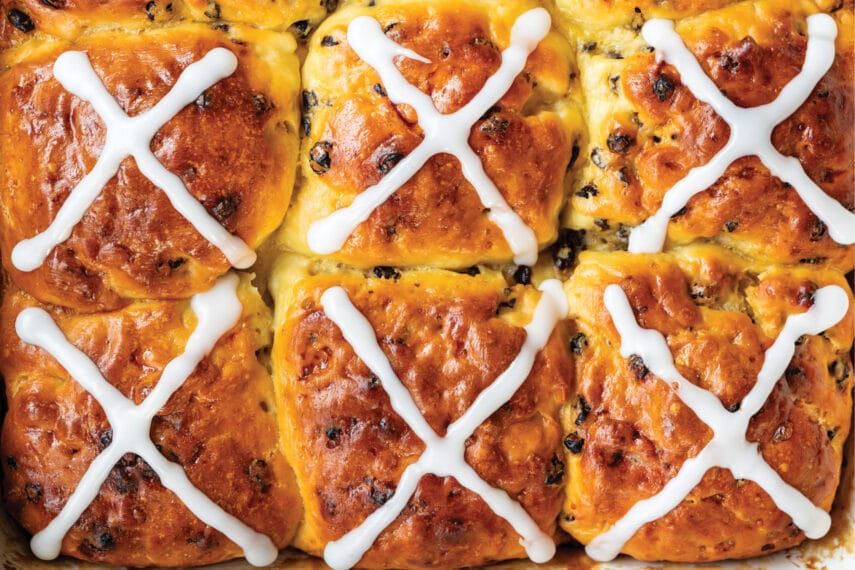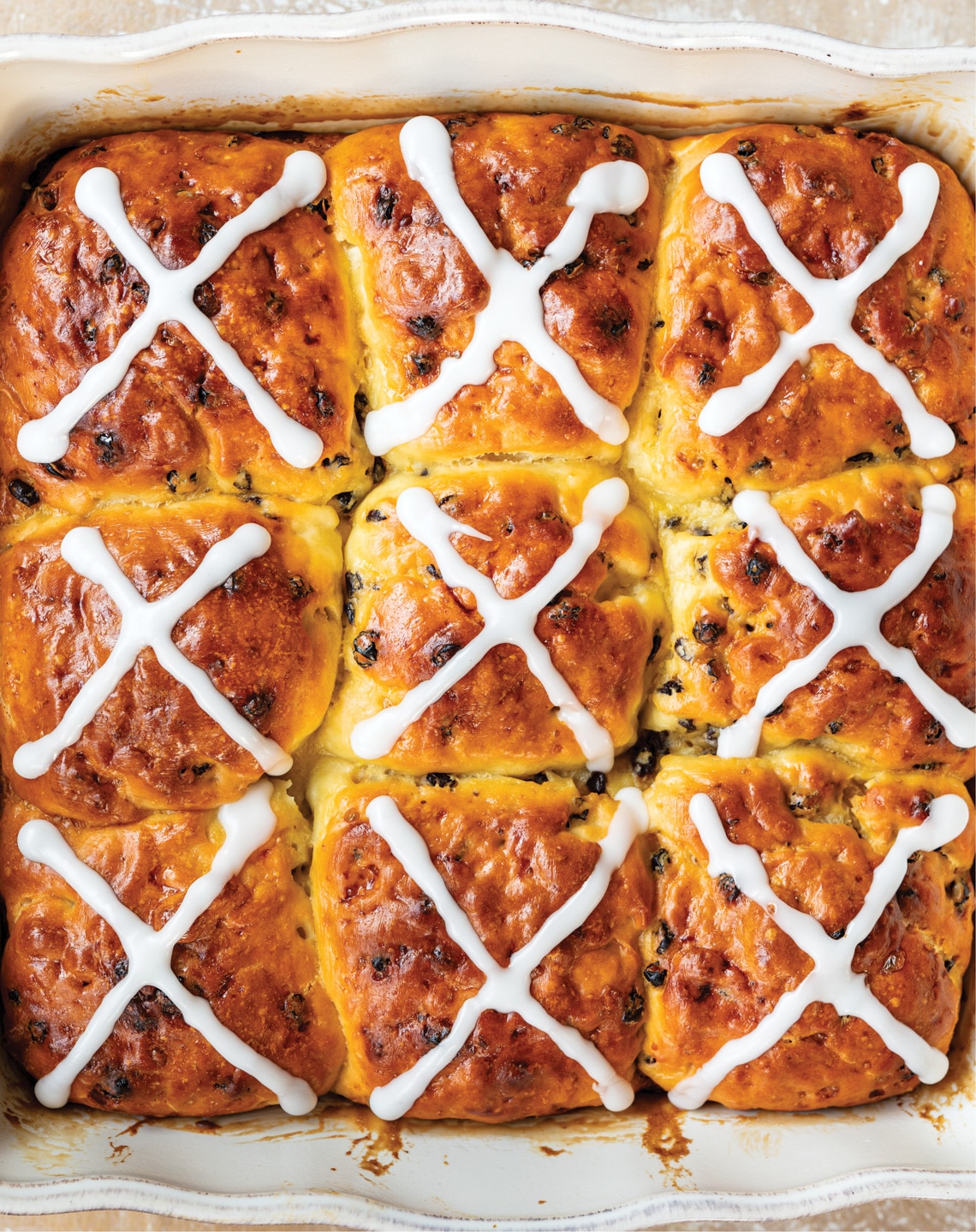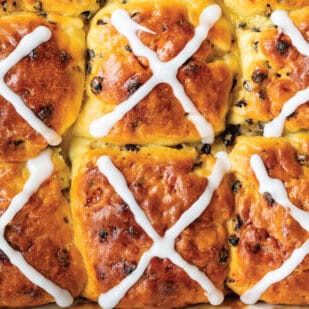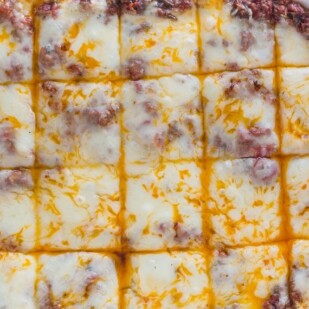Low FODMAP Hot Cross Buns? YES! Did you know that currants have a low FODMAP serving of 1 Australian tablespoon or 13 g? This recipe has the perfect amount. The recipe is from The Flour Craft Bakery & Café Cookbook by Heather Hardcastle, in which we found many gluten-free recipes that we couldn’t wait to make – some being low FODMAP as presented, such as this one, and others requiring just a gentle tweak.

Check out her Vegan Low FODMAP Fruit Crumble Bars, too.
Notes on Ingredients & Technique
The blend of flours and starches is key and will make your buns light and fluffy as shown in these images. Please use what is asked for.
Xanthan gum is low FODMAP and is necessary in this recipe for the proper texture in your buns; do not leave it out.
Note that you do have to build in the proofing time. As always, read the recipe through the familiarize yourself with the entire process before beginning.
Make sure to allow the buns to cool completely before applying the icing! Heather uses orange juice in her icing for more flavor and it finishes these buns off perfectly.
Adapted and published with permission. The Flour Craft Bakery & Café Cookbook by Heather Hardcastle. Published by Rizzoli, 2021. Photography by Erin Scott.Heather’s Tips
From Heather: Everyone’s favorite Easter treat! These are an extremely popular item at our bakeshops every spring. They’re an adaptation of our Buttery Brioche Loaves with traditional spices and fruits added. They’re easy and fun to make with kids on a long holiday weekend. To shape, form loose balls of dough and press them close together in a 9 x 13-inch buttered baking pan. Allow the buns to proof so they grow together and they’ll bake up like pull-apart rolls. Don’t forget to put an icing cross on each bun, the traditional decoration.

FODMAP Information
Our recipes are based on Monash University and FODMAP Friendly science.
- Butter: Both Monash University and FODMAP Friendly have lab tested butter. Monash states that a low FODMAP Green Light portion is 1 tablespoon or 19 g and also states that “butter is high in fat and does not contain carbohydrates (FODMAPs)”. FODMAP Friendly gives it a “Pass” at 1 tablespoon or 19 g. Both recommended serving sizes are presented as part of healthy eating guidelines, not as maximum FODMAP serving size. Fat can affect guy motility and trigger IBS symptoms in some people. Eat to your tolerance.
- Eggs: Eggs are high in protein and do not contain carbohydrates, according to Monash University.
- Sugar: Monash University and FODMAP Friendly have both lab tested white, granulated sugar. Monash states that a Green Light low FODMAP serving size of white sugar is ¼ cup (50 g). FODMAP Friendly simply states that they have tested 1 tablespoon and that it is low FODMAP. Regular granulated white sugar is sucrose, which is a disaccharide made up of equal parts glucose and fructose. Sucrose is broken down and absorbed efficiently in the small intestine.
Please always refer to the Monash University & FODMAP Friendly smartphone apps for the most up-to-date lab tested information. As always, your tolerance is what counts; please eat accordingly. The ultimate goal of the low FODMAP diet is to eat as broadly as possible, without triggering symptoms, for the healthiest microbiome.

Low FODMAP Hot Cross Buns
Low FODMAP Hot Cross Buns? YES! Did you know that currants have a low FODMAP serving of 1 Australian tablespoon or 13 g? This recipe has the perfect amount. The recipe is from The Flour Craft Bakery & Café Cookbook by Heather Hardcastle, in which we found many gluten-free recipes that we couldn’t wait to make – some being low FODMAP as presented, such as this one, and others requiring just a gentle tweak.
Low FODMAP Serving Size Info: Makes 12 buns; 1 bun per serving; 12 servings
Ingredients:
- 1 cup (144 g) Currants
- ½ cup (120 ml) Warm water
- 2 cups (260 g) Cornstarch
- ½ cup (65 g) Tapioca starch
- ½ cup (75 g) Brown rice flour
- ¼ cup (35 g) Millet flour
- 2 tablespoons White sugar
- 1 tablespoon Instant yeast
- 1 tablespoon Xanthan gum
- 1½ teaspoon Kosher salt
- 1 teaspoon Ground cardamom
- 1 ¼ cups (300 ml) lactose-free Whole milk, at room temperature
- 3 large eggs, at room temperature
- 2 teaspoons Vanilla extract
- 1 tablespoon Orange zest from 1 orange
- 1 cup (2 sticks; 226 g) unsalted butter, soft, cut into cubes
- 1 large egg yolk, for egg wash before baking
- 1 cup (90 g) Powdered sugar
- ¼ cup (60 ml) freshly squeezed orange juice, from 1 orange
Preparation:
-
Soak the currants in warm water for 10 minutes while you mix the dough.
-
In the bowl of a stand mixer fitted with the paddle attachment, combine the cornstarch, tapioca starch, brown rice flour, millet flour, white sugar, instant yeast, xanthan gum, salt, and cardamom. Mix together on low speed until well combined. Add the milk, eggs, vanilla, and orange zest and mix on high speed for 3 minutes to aerate the dough. The dough will appear glossy and pale at this stage and will give the resulting buns a light, airy texture. With the machine running on low speed add the soft butter, one piece at a time, until all the butter has been added. Drain the water from the currants and add them to the dough. Turn the machine on high and mix for another 3 minutes to emulsify. The dough should be shiny and sticky.
-
Transfer the dough to an oiled bowl and cover the bowl with plastic. Allow to proof at room temperature for about 2 hours. Once the dough has finished its bulk proofing, and doubled in size, shape it into rolls.
-
If using ring molds, place them on a parchment-lined baking sheet and spray each mold thoroughly with cooking spray. If using a 9 x 13-inch (23 cm by 33 cm) pan, spray the pan thor-oughly with cooking spray.
-
Using wet hands, pick up an orange-sized ball of dough, about ⅓ cup, and toss the ball back and forth between your hands, like you’re making a snowball or using a similarly light touch as when shaping a hamburger patty. When formed into a nearly round shape, place the ball of dough into a mold or the baking pan. Proceed until all the dough has been formed. Spray the top of the dough with cooking spray and cover with plastic wrap. Refrigerate overnight to finish proofing.
-
The next morning, preheat the oven to 325°F (165°C) . Make an egg wash by whisking together egg yolk and 1 tablespoon of water. Brush the top of the buns with egg wash. Bake for 20–25 minutes, rotating the pan halfway through baking. The buns are done when the tops are light golden brown. Cool in the pan completely before unmolding.
-
When the buns are completely cool, mix the glaze. Whisk together the powdered sugar and orange juice until smooth and shiny. Depending on how juicy your orange is, you might not use all the juice. Or, if you find your glaze is too dry, add some water, 1 teaspoon at a time, until the glaze is smooth and thick and no lumps remain. Pipe or spoon the glaze over the buns to form the distinctive cross design. Allow the glaze to set at room temperature before serving.
Notes:
FODMAP Information
Our recipes are based on Monash University and FODMAP Friendly science.
- Butter: Both Monash University and FODMAP Friendly have lab tested butter. Monash states that a low FODMAP Green Light portion is 1 tablespoon or 19 g and also states that “butter is high in fat and does not contain carbohydrates (FODMAPs)”. FODMAP Friendly gives it a “Pass” at 1 tablespoon or 19 g. Both recommended serving sizes are presented as part of healthy eating guidelines, not as maximum FODMAP serving size. Fat can affect guy motility and trigger IBS symptoms in some people. Eat to your tolerance.
- Eggs: Eggs are high in protein and do not contain carbohydrates, according to Monash University.
- Sugar: Monash University and FODMAP Friendly have both lab tested white, granulated sugar. Monash states that a Green Light low FODMAP serving size of white sugar is ¼ cup (50 g). FODMAP Friendly simply states that they have tested 1 tablespoon and that it is low FODMAP. Regular granulated white sugar is sucrose, which is a disaccharide made up of equal parts glucose and fructose. Sucrose is broken down and absorbed efficiently in the small intestine.
Please always refer to the Monash University & FODMAP Friendly smartphone apps for the most up-to-date lab tested information. As always, your tolerance is what counts; please eat accordingly. The ultimate goal of the low FODMAP diet is to eat as broadly as possible, without triggering symptoms, for the healthiest microbiome.
Nutrition
All nutritional information is based on third-party calculations and should be considered estimates. Actual nutritional content will vary with brands used, measuring methods, portion sizes and more. For a more detailed explanation, please read our article Understanding The Nutrition Panel Within Our Recipes.








